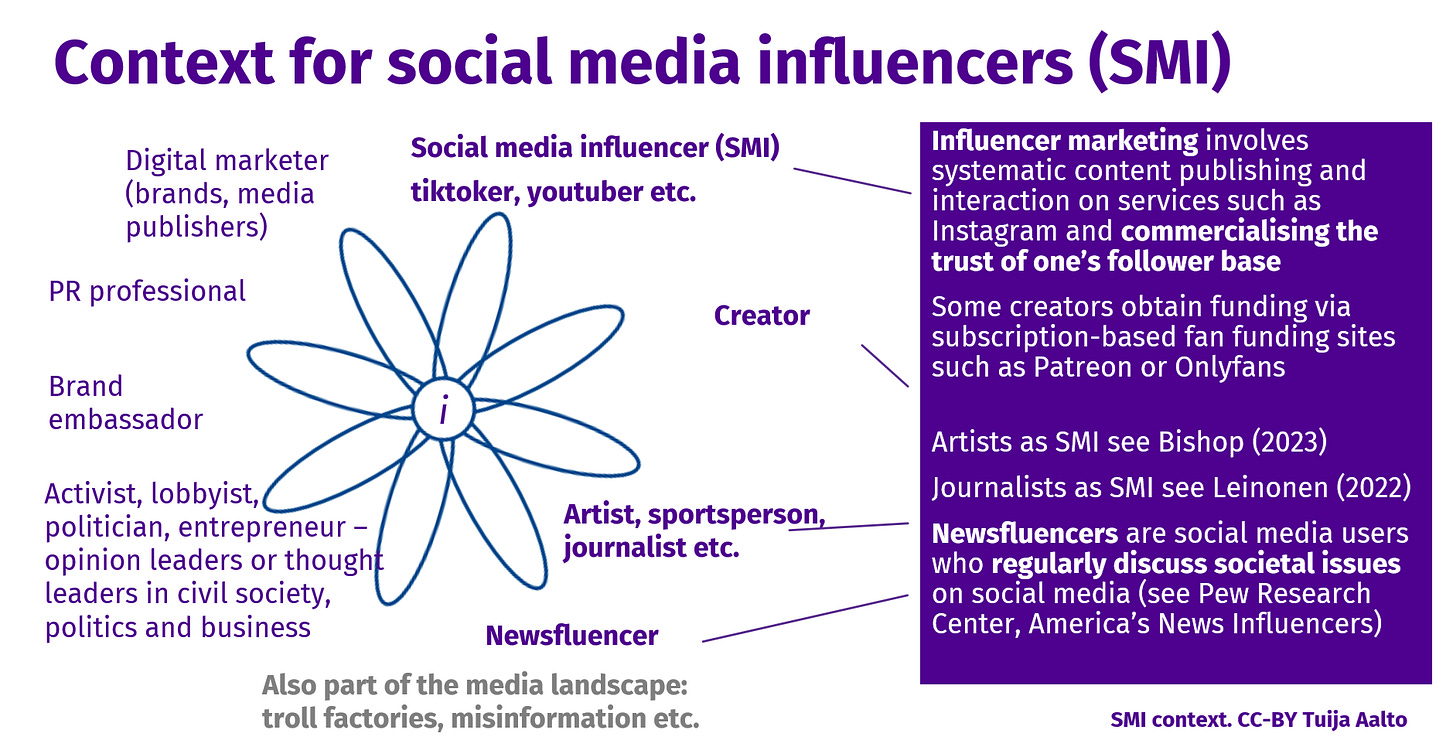Influencers and influencer marketing defined, plus context
Influencers are people who successfully commercialize their social media following
The media landscape is saturated by people communicating with an agenda. They include personal brands such as social media influencers (SMI) or creators, as well as activists, politicians, business owners and entrepreneurs. Not all of them are part of what we call Influencer industry (Hund 2023) but they are part of today’s hybrid media landscape (Chadwick 2017).
I crafted the context flower image below to convey the idea of the multiple goal-oriented actors online ranging from SMI to creators to artists, sportspeople and journalists as doing commercial collaborations and to “newsfluencers”, people who actively address societal themes online (Pew Research Center 2024).
How does it work for you? Do you find yourself in the picture? If not, what am I missing?
What are social media influencers and what is influencer marketing?
For practical purposes, influencers are those who successfully commercialize their social media following, and Influencer marketing involves brands compensating influencers for relaying their messages to their followers.
For more theoretical definitions, consider these:
Influencer marketing is the strategic use of influencers for marketing communication to change people’s attitudes and behaviours across various domains (Hudders et al 2021)
Or Kozinets et al (2023): “The shorter-to-medium term and tactical involvement of influencers and creators in marketing communication campaigns designed primarily for revenue generation —”.
Kozinets et al (2023) define influencers as “people who build relationships with their audiences by delivering consistent, authentic, and distinct performances that are linked to a personal brand and shared on social media. They may or may not have brand deals, large audiences, or a focus on their ‘real lives’.”
What can we expect from social media influencers in terms of ethical code of conduct? It depends on the individual. According to Wellman et al (2020) influencers use the concept of authenticity as an ethical framework which steers them to being true to one’s self and brand, as well as being true to one’s audience.
Have you seen an evocative visualization of actors within the influencer industry? Do share! While my research focuses on the Finnish influencer industry, it will certainly be fruitful to compare industry figurations internationally.
References
Bishop, S. (2023). Influencer creep: How artists strategically navigate the platformisation of art worlds. New Media & Society. https://doi.org/10.1177/14614448231206090
Chadwick, A. (2017). The hybrid media system: Politics and power. Oxford University Press.
Hudders, L., De Jans, S., & De Veirman, M. (2021). The commercialization of social media stars: a literature review and conceptual framework on the strategic use of social media influencers. International Journal of Advertising, 40(3), 327–375. https://doi.org/10.1080/02650487.2020.1836925
Hund, E. (2023). The influencer industry: The quest for authenticity on social media. Princeton University Press.
Hurcombe, E. (2024). Conceptualising the “Newsfluencer”: Intersecting Trajectories in Online Content Creation and Platformatised Journalism. Digital Journalism, 1–12. https://doi.org/10.1080/21670811.2024.2397088
Kozinets, R, Gretzel, U. and Gambetti, R. (2023). Influencers and creators: Business, culture, and practice. SAGE Publications Ltd, 384 pp., (hardcover), ISBN 1529768640
Leinonen, S. (2022) Can Journalists be Influencers? How to engage hard-to-reach audiences on social media https://blogs.lse.ac.uk/polis/2022/06/28/can-journalists-be-influencers-a-new-research-report-on-engaging-audiences-on-social-media/
Reinikainen, H., & Arnesson, J. (2024). Influencer Politics: At the Intersection of Personal, Political, and Promotional (Vol. 23). De Gruyter. https://doi.org/10.1515/9783111036106
Wellman, M. L., Stoldt, R., Tully, M., & Ekdale, B. (2020). Ethics of Authenticity: Social Media Influencers and the Production of Sponsored Content. Journal of Mass Media Ethics, 35(2), 68–82.





